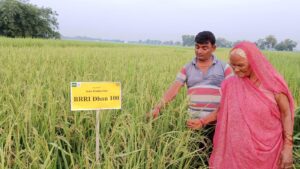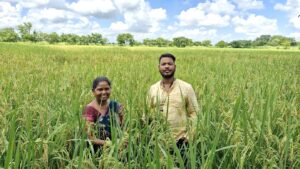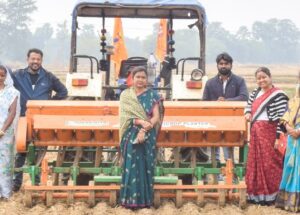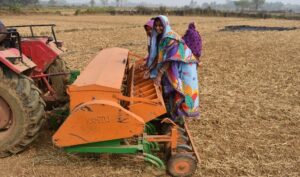“My story of going into agriculture is like an irony of ironies,” Shaobing Peng recalls. “In 1979, when I took the university entrance exams, which were given every summer in China, my score wasn’t high enough. It was just a little above the passing mark.”
Since his parents were not well educated, the future Dr. Peng sought advice from his classmate’s father. He said he remembered asking, “Uncle, with my score, what university should I apply for?” Without hesitation, his elder replied, “You go to an agricultural university.”
“That came to me as a big shock,” Dr. Peng recounts fondly. “I never considered going into agriculture.” His classmate’s father told him that this was his best chance if he wanted to be accepted by a major university.
Back then, Dr. Peng said that he dreamed of going to bigger cities where major universities were located and he realized that, indeed, that was his best chance to live his dream. “So, I chose agriculture, got accepted, and studied at Huazhong Agricultural University in Wuhan.”
Joining IRRI
Years later, Dr. Peng received his master’s degree at the University of California (UC), Davis, where he met Kenneth Cassman, who became his thesis adviser and, later on, also became one of the division heads at the International Rice Research Institute (IRRI). When Dr. Peng finished his PhD at Texas Tech University and was doing 15 months of postdoctoral work at the Citrus Research and Education Center at the University of Florida, Dr. Cassman sent him a letter encouraging him to apply for a job at IRRI.
“It wasn’t an easy decision to make,” Dr. Peng says. “I had to decide whether I wanted to stay in America or go to the Philippines. I couldn’t make an outright decision but, nevertheless, I gave the interview a try and flew to the Philippines.”
He arrived in the country in early January of 1991. During his interview, he met Dr. Klaus Lampe, who was then the IRRI director general. He told Dr. Peng that IRRI never had a full-time scientist from mainland China and offered him work with the Institute.
During his undergraduate years in China, both his textbooks and his professors often mentioned IRRI. “As early as then,” Dr. Peng adds, “IRRI was ingrained in my mind as it had long been internationally recognized for its rice research. I knew IRRI was the best. So that helped me decide to join the organization.”
But his decision met with another setback. In the early 1990s, China was still not that open to the world and Dr. Peng needed to get permission from his government to allow him to work at IRRI. So, Dr. Lampe did all he could to convince the Chinese government, the Ministry of Agriculture, and Dr. Peng’s former university to allow the then young scientist to work at IRRI. His efforts paid off.
All about teamwork
Dr. Peng joined the Agronomy, Plant Physiology, and Agroecology Division headed by Dr. Cassman. He worked closely with plant breeders such as World Food Prize Laureate Dr. Gurdev Khush (watch IRRI Pioneer Interviews–Challenges for IRRI: Gurdev Khush) on some projects that included improving the yield potential of rice. One of the most memorable projects he came across was a field trial of a new plant type material—an improved tropical japonica variety—in the dry season of 1994. He said the crop looked beautiful in the field and his whole team visited the field almost every day.
“Everybody was hopeful that, finally, we were going to break the yield barrier in rice—more than 10 tons per hectare,” Dr. Peng says. Their high hopes, however, got burned when, 2–3 weeks before the crop matured, brown planthoppers attacked and destroyed the whole field.
“That experience taught us that breaking the yield barrier of rice is not that easy,” Dr. Peng explains. “This is because it requires more people working from different directions, in different disciplines, such as plant breeders along with agronomists, and it also needs more research funds to support it.
“The work of crop physiologists,” he adds, “plays a supporting yet important role for plant breeders and agronomists. Not only should they be willing to patiently wait a little longer to see an impact, but they should also be willing to play a minor part in a bigger team, so multidisciplinary collaboration would work.”
More time in the field
He advises young crop physiologists to devote a little more time to the field rather than to the laboratory because, while they may find molecular techniques or approaches truly interesting, they should also study a plant in its real environment because interaction between a crop and its environment is very important.
Dr. Peng recommends IRRI as a good place to do good science, especially for his field of study. “I’ve never seen a better place to do crop physiology research anywhere in the world but IRRI because there’s a good national staff for support and plenty of fields,” he explains. “That is why I had a productive career at IRRI.”
In one of his studies, for example, Dr. Peng investigated high nighttime temperatures as one of the likely causes for a 15% drop in rice yields. He noticed that, in the dry seasons of 1999 to 2001, his team couldn’t get a yield of 9–10 tons per hectare. Instead, their yields just nudged 7–8 tons per hectare despite using the best varieties and management practices in fields.
“Before 1999, we could easily reach 9–10 tons per hectare in the dry season, so I was a little bit worried and asked myself what was going on,” Dr. Peng says. “I analyzed the weather data of these three seasons and found out that they all had higher nighttime temperature. I sent a message to everyone in the Institute to report this observation.”
But Dr. Peng believed that he needed to investigate more. So, he used crop yield and weather data from 12 seasons (1992-2003) and found a strong negative relationship between crop yield and seasonal average nighttime temperature— the higher the temperature, the lower the yield. The result was published in a major scientific journal, Proceedings of the National Academy of Sciences of the United States of America .
“Not only do I think that this was my most interesting research, but it also had a high impact across the rice research community,” Dr. Peng shares. “This article has been cited by other researchers 148 times since 2004.
“Staying with IRRI for 19 years will make it difficult for me to say that it has never had or will never have a place in my life,” he continues. “I have always strived to do something good for IRRI because I believe in its goals and mission of feeding the world.
“When I go back to China, I aspire to organize people from high positions and IRRI alumni to do something collectively for IRRI,” Dr. Peng says, his eyes smiling, brimming with hope for the future. “Once I take up my new post at Huazhong Agricultural University, one of my missions will be to prepare the next generation of crop physiologists.”
Agriculture was an unlikely choice for Dr. Peng when he started his career in China many years ago. “But looking back now,” he says, “I have no regrets in choosing agriculture. It turned out to be a good decision.
____________________________________
Ms. Ferrer is a science communication specialist at the International Rice Research Institute.










